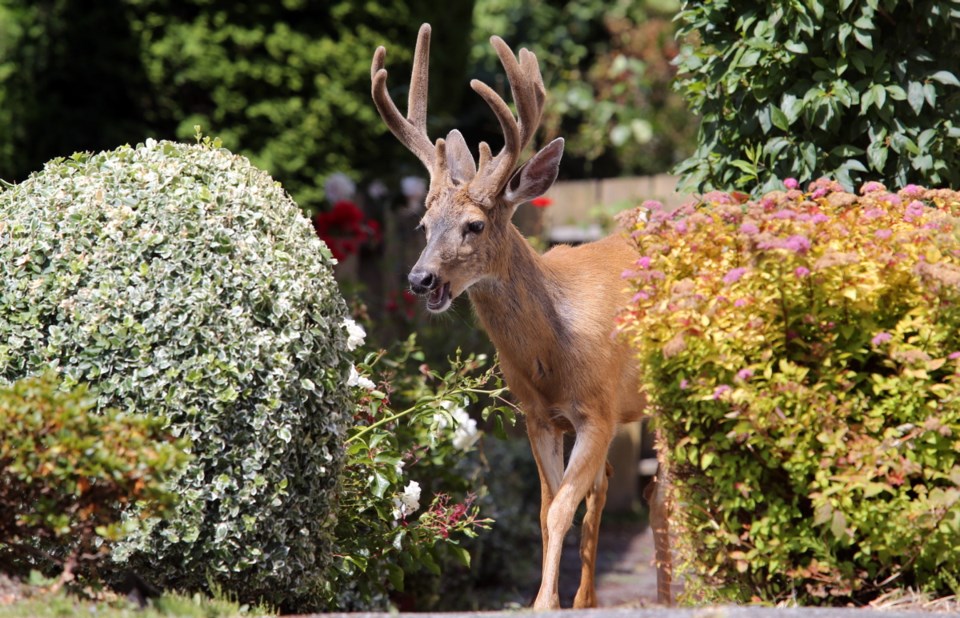 When we moved to our current home three years ago, we were excited to be living in the forest. Now that forest is under threat.
When we moved to our current home three years ago, we were excited to be living in the forest. Now that forest is under threat.
Granted, it wasn’t the forest primeval when we arrived. Human activity had taken its toll — the area was logged 80 or 100 years ago, and Scotch broom and other species have invaded disturbed patches of land.
We cleaned up heaps of garbage from the property and began clearing away broom and blackberries. It’s a never-ending campaign, but we’ve made much headway. Native plant species are faring better on rocky slopes that were once covered with broom.
Where Himalayan blackberries once reigned, we have found red columbine two years in a row. Fawn lilies, trilliums and orchids began to make their appearance where invasive vegetation was removed.
But there has been a change for the worse, and it can be described in one word.
Deer.
We expected the ungulates to nibble on landscaping plants and ravage fruit trees, and they did, sparing few. But that’s all in the game, part of the price of being close to nature. What we didn’t expect was damage the deer are doing to the native habitat we are trying to rejuvenate.
The deterioration is noticeable, and accelerating. At this rate, the forest will be much poorer in a few years, the plant life much less diverse. That means less habitat for songbirds. There will likely be increasing problems with erosion and invasive plants.
It’s a bleak outlook and it’s not just my imagination.
Peter Arcese, who holds the Forest Resources B.C. Chair of Applied Conservation Biology at the University of British Columbia, has done extensive study of the effect of deer populations on habitat. The research he led was conducted at 66 sites on 35 islands and the mainland.
Arcese and his team found that where there are deer and no predators, the damage was heavy to native vegetation and cultural species (plants traditionally managed by First Nations before European settlement). The reduction in native vegetation was calculated to be 52 to 85 per cent.
On islands with deer and predators, the damage was less, although the effect on vegetation was still measurable. On islands with no deer, the plant ecosystem was healthiest.
The richness and extent of plant cover declines drastically, Arcese concluded, when deer numbers exceed about one animal per 10 hectares. It’s an unhealthy situation for plant systems, and it’s bad for the deer — they will ultimately run out of food.
It’s tempting to think that if we just left the deer alone, nature’s balance would return, but that ship has sailed. We humans have displaced the predators that kept the deer in control. Doing nothing will only allow the situation to worsen, for the environment and the deer.
“I think most of the public is still unaware that encouraging deer populations is tantamount to encouraging the local extinction of a host of plants, insects and birds that rely on them via the resulting trophic cascade [the disruption of the ecological chain by the removal of a predator],” Arcese told me.
“In addition, one has to wonder about the ethics of maintaining a deer population limited by starvation and disease.”
I went outside one night last week and shone a flashlight around; seven pairs of eyes glowed back at me from the darkness within a few metres of our house. There are many more deer than that in our neighbourhood, and the forest environment shows it.
Two or three deer have been killed by a cougar on our property in the past couple of years, but that’s not enough. Perhaps the province could lend us a few of those wolves deemed to be surplus in the Interior.
Some people say we should leave those beautiful, graceful animals alone, that we should not mess with nature. An infatuation with cuteness, though, is not really a love of nature. Those who truly love nature recognize the need for checks and balances. They appreciate all of nature’s processes and life cycles, not dispassionately, but objectively.
Humans are part of nature, but unlike the deer, we can recognize when we are damaging the environment. And where there are too many deer, we perpetuate the damage when we do nothing.
What is the solution? I wish I knew.



